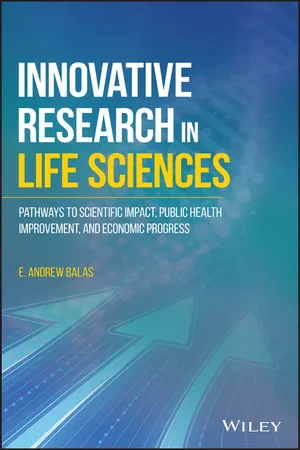
Innovative Research in Life Sciences
Pathways to Scientific Impact, Public Health Improvement, and Economic Progress
- English
- ePUB (mobile friendly)
- Available on iOS & Android
Innovative Research in Life Sciences
Pathways to Scientific Impact, Public Health Improvement, and Economic Progress
About This Book
"I thoroughly enjoyed reading this book as it has taken me on a journey through time, across the globe and through multiple disciplines. Indeed, we need to be thinking about these concepts and applying them every day to do our jobs better."
Farah Magrabi, Macquarie University, Australia
"The reader will find intriguing not only the title but also the content of the book. I'm also pleased that public health, and even more specifically epidemiology has an important place in this ambitious discussion."
Elena Andresen, Oregon Health & Science University, USA
"This book is very well written and addresses an important topic. It presents many reasons why basic scientists/researchers should establish collaborations and access information outside traditional means and not limit thinking but rather expand such and perhaps develop more innovative and translational research ventures that will advance science and not move it laterally."
Gerald Pepe, Eastern Virginia Medical School, USA
"This book gathers logically and presents interestingly (with many examples) the qualities and attitudes a researcher must possess in order to become successful. On the long run, the deep and carefully reexamined research will be the one that lasts."
Zoltán Néda, Babe?-Bolyai University, Romania
"I really liked the five pillars delineating the components of humanism in research. This book has made a major contribution to the research ethics literature."
David Fleming, University of Missouri, USA
A comprehensive review of the research phase of life sciences from design to discovery with suggestions to improve innovation
This vital resource explores the creative processes leading to biomedical innovation, identifies the obstacles and best practices of innovative laboratories, and supports the production of effective science. Innovative Research in Life Sciences draws on lessons from 400 award-winning scientists and research from leading universities. The book explores the innovative process in life sciences and puts the focus on how great ideas are born and become landmark scientific discoveries. The text provides a unique resource for developing professional competencies and applied skills of life sciences researchers.
The book examines what happens before the scientific paper is submitted for publication or the innovation becomes legally protected. This phase is the most neglected but most exciting in the process of scientific creativity and innovation. The author identifies twelve competencies of innovative biomedical researchers that described and analyzed. This important resource:
- Highlights the research phase from design to discovery that precedes innovation disclosure
- Offers a step by step explanation of how to improve innovation
- Offers solutions for improving research and innovation productivity in the life sciences
- Contains a variety of statistical databases and a vast number of stories about individual discoveries
- Includes a process of published studies and national statistics of biomedical research and reviews the performance of research labs and academic institutions
Written for academics and researchers in biomedicine, pharmaceutical science, life sciences, drug discovery, pharmacology, Innovative Research in Life Sciences offers a guide to the creative processes leading to biomedical innovation and identifies the best practices of innovative scientists and laboratories.
Frequently asked questions
Information
Part One
Outcomes of Research
1
Pathways of the Research Innovator
Scientists must have the courage to attack the great unsolved problems of their time.Otto Warburg (1964) 1
Diverse Outcomes of Science
Table of contents
- Cover
- Table of Contents
- Preface
- Part One: Outcomes of Research
- Part Two: Headwinds of Research Innovation
- Part Three: Boosters of Research Productivity
- Part Four: Atmosphere of Excellence
- List of Award-winning Scientists and Serial Innovators
- Subject Index
- End User License Agreement